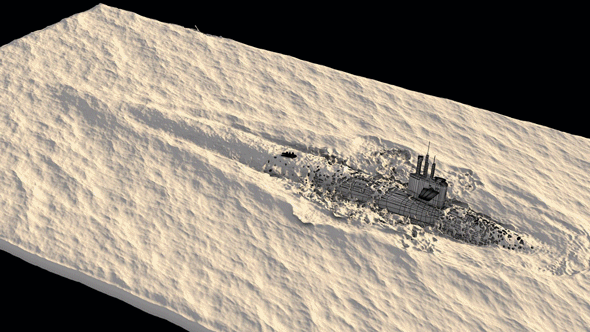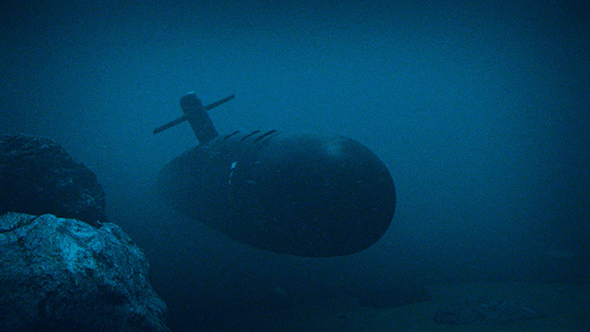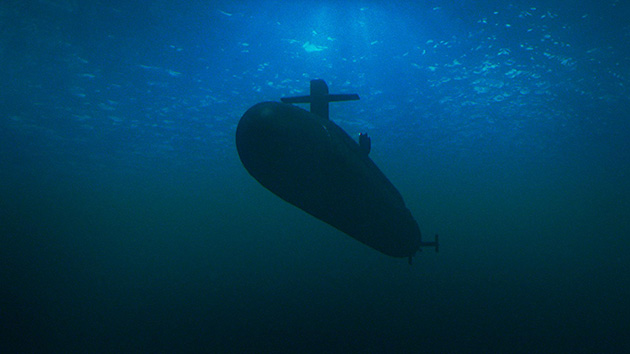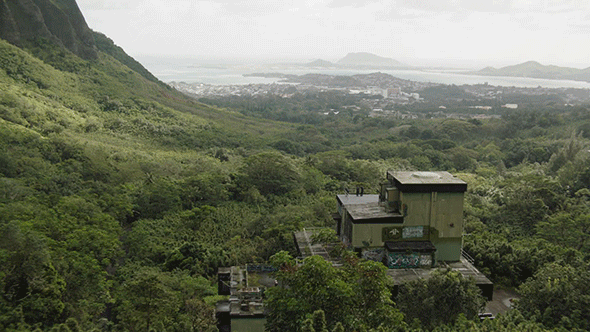How FuseFX Pushed Water and Particle Sims to the Limit for Episodic TV
As TV shows go, it's pretty high concept. The crew of the U.S.S. Colorado, a U.S. Navy submarine loaded with missiles, questions an order to fire nukes at Pakistan and is suddenly treated as an enemy combatant, taking potentially deadly fire from another American sub. Left for dead at the bottom of the sea, the crew finds a remote island where they commandeer a communications facility and begin operating autonomously, using the threat posed by their sub's nuclear firepower to keep the world's military powers at bay.
Last Resort's pilot debuted on ABC last night. For that episode alone, the story demanded that visuals be created depicting the submarine surfacing under a raft filled with Navy SEALS, smacking into the ocean floor, and evading a cruise missile as it dives into the water. Later, another missile erupts through the water's surface. Watch the following video clip to see some VFX breakdowns from the show, then read on to learn more about how the effects were accomplished.
Shawn Ryan, the show's executive producer and co-creator (with Karl Gajdusek), is well-known for The Shield and The Unit, but said Last Resort is "without a doubt" the most VFX-reliant show he's worked on. Fortunately, Ryan already had a good relationship with VFX facility FuseFX and its founder and VFX supervisor, David Altenau, who worked on The Unit for four seasons, as well as on other Ryan projects including Lie to Me, Terriers, and Chicago Code. That helped raise Ryan's confidence level, although he admits to being a little nervous about all those VFX shots while the show was being planned.
"I started off worried from a quality standpoint," he told StudioDaily. "I've become less nervous because I'm super-impressed with the work they've done. You do have to pick your spots, because it can be expensive, but the longer you can prepare, the better things are budgetwise and creatively. So we've given them a good heads-up on the things we're going to need weeks ahead of time. We don't have stories being broken at the last moment."
In fact, Fuse FX had some serious space for planning before it had to start delivering shots for the show. The company spent three months developing water-simulation pipelines, working with underwater environments, and developing models that would be used for the project. That lead time gave Altenau and his team the confidence to suggest executing full-CG shots for the pilot, rather than combining live-action plates with CG elements. All-CG imagery allows Fuse FX to completely control camera moves and shot compositions for the best dramatic effect in any given shot. And, with much of the heavy-duty development work out of the way before production began in earnest, the team is able to quickly and efficiently build out new scenes. But it does demand a previs process that's rigorous by TV standards.
The pilot episode was directed by Martin Campbell, who gave the team a full set of storyboards showing what he wanted to accomplish in the VFX shots. "We took it on ourselves to incorporate previs into our normal shot design, going through a rigid process before we commited to the renders," Altenau said. "The water sim is massive — we have 30 TB dedicated to simulation data for it. So I had a series of great conversations with each director, explaining what we were doing. They got a chance to look at and comment on every element of composition, speed, and camerawork, which made the shots much more efficient for us. By the time we actually do them, we're highly confident we're making something that fits the timing and pace of the show."
As a result, Ryan and Gajdusek had VFX on their mind in the writers' room. "We had an episode that filmed a week and a half ago that we knew was going to require a lot of underwater VFX," Ryan recalled. "Even as we were breaking the story, we were breaking down the shots we knew we'd need. David spoke with us about what we needed, how much, and what effect we were after. And the director talked specifially about angles and sizes of things. Those conversations happen pretty quickly. When we start seeing previs, we make sure it's not too far afield from what we've imagined, and we have time to correct things. For example, in the third episode there was a scene with a submarine going through underwater canyons. When I first watched it, I felt the submarine was traveling too fast. It felt reckless and dangerous. I thought we'd want them at more of a crawl, carefully going through the canyons. So you give them that note, and you're doing it well enough in advance that you can make those adjustments."
Elaborate Water Simulations

FuseFX had its work cut out for it from square one, with one of the most elaborate VFX shots coming just a few minutes into the pilot. The hero sub surfaces directly underneath a Zodiac boat full of Navy SEALS. "It was a big aerial shoot," Altenau explained. "There was an actual group of former Navy SEALs cruising around Hawaii a mile or two off shore, and that was essentially the set-up shot for our submarine reveal. We knew the angles we wanted to hit and how wide we wanted to be. We shot an aerial rotation around the Zodiac because we weren't really sure how much photography we'd use — we thought we might use the practical boat and actors as part of the CG shot. But as the shot evolved, we elected to go all-CG, even for the SEALs. They cut from the live-action helicopter shot of the seals to a tight shot, and then we go to an almost identical angle for the sub pick-up that's all CG. Because we were one cut away from a full practical shot from the helicopter, our very first shot was incredibly demanding, not just in the attention to detail but in achieving an exact match with the water lighting, the look of the waves, the CG digital doubles, and the Colorado rising up underneath. It was a huge, amazing shot that we were really excited about, and it works great. But there were some big challenges."
Key to the success of this shot and others like it was FuseFX's intensive water-simulation work. "Water simulation in TV is very rare, because it's a complex procedure and most television budgets and schedules don't allow the time it takes to do that work," explained FuseFX CG and Animation Supervisor Matt Von Brock. "We evaluated a couple of pieces of software early on and found a package called Naiad [from Exotic Matter]. It wasn't really built to work with our pipeline, so we had to develop a lot of other tools, bringing in other pieces of software, to make it all come together. Naiad gives us particle simulations, showing us how water reacts with other objects, creating surface foam and spray and splash elements. We brought in [Thinkbox] Krakatoa and Frost to generate the water surface from the simulation data."
The use of Naiad created another complication, Altenau noted, when Autodesk suddenly purchased the technology just as FuseFX was ramping up for Last Resort. FuseFX made it in under the wire, purchasing another half-dozen licenses just before Autodesk stopped selling the product.
Shots are rendered primarily in Chaos Group V-Ray and color-timed in-house using Assimilate Scratch. "There are no [live-action] plates for color reference in all-CG shots, so we have the ability to do a really robust color-timing to help control the final look of the shots," Altenau said. "Production still does a final color timing pass on the shots as they go into the show, but only after we’ve set a color palette as the shots are delivered."
Under the Sea
The next big FX sequence in the pilot has the Colorado coming under attack by other Navy forces, with a simulated aerial shot following a cruise missile as it dives into the water. Once again, FuseFX started with live-action plates, working from the idea that CG elements would be composited into those shots. And, once again, they decided to go all-CG. "For the pace of the show and the way the cutting needed to work, it tied our hands too much to stick to the live-action plates," Altenau said. "We had already crossed that threshhold, so we dumped the practical plates and created CG cloud environments and sky environments."

The attack culminates in the Colorado making a hard landing on the ocean floor. "In previs, we went through multiple iterations to perfect the speed, impact, and momentum of the sub to tell the story in a way that's intense," he said. "The landing causes some damage, but it's not unrecoverable. The shot involved a full environment, creation of the ocean's bottom, and intense fluid-dynamics and particle simulations as the sub slides to a hard stop."
"Doing the sub under water was an easy process for us, but kicking up the sand was complicated," Von Brock explained. "The challenge was getting the sand that kicks up to fit around the front of the sub, breaking around the nose. I had to run through a lot of procedural set-ups to create emitters to emit the smoke from the ground. I had to tell the software where the sub was touching the ground, to generate smoke, and then to set the forces — turbulence and wind and the impact speed of the sub — that generate the sand that kicks up."
Remaking Real Sets and Environments
The Colorado's crew eventually takes refuge on an island where they commandeer a NATO listening post, part of the old Cold War system for monitoring ballistic missiles and attack submarines, as their base of operations. The set is an actual U.S. naval station built in a Hawaiian canyon in the 1940s — seemingly a perfect scenic location for the show. However, the actual building looks abandoned and outmoded — it's covered with graffiti, for one thing. "We created a new shell for the building to establish it as a modern communication center, covered with satellite dishes and microwave antennas and all the technology that will allow them to control their fate," Altenau says. "Every time they show that building, we're replacing it with a CG surrogate. And the view out in the bay is a combination of live-action elements and a massive matte painting."
The island setting offers another big moment when the sub shows up in the bay. Altenau shot "hundreds" of reference pictures with a Canon 5D, figuring out what the island would look like as seen from the water. A matte painting of the island was created, and shots showing the sub entering the harbor are, again, full CG shots that take place in front of a matte painting made up of digitally augmented photography in the background. The environment was used to create a series of shots showing the sub pulling into the harbor, taking the Zodiac boats to land, and dealing with the local residents. Some other, more traditional invisible VFX work was used in shots of the sub interior to extend the scope of the missile room, where three missile tubes were built but 24 missile tubes can be seen lined up in the final shots, stretching back into the distance, through simple use of green-screen effects.
Finally, there's a shot that conveys the true leverage the Colorado crew has over the military forces that might be marshalled to destroy them. "In order to make the story believable, the viewer has to understand the power of the nuclear sub they are using," Altenau said. "When they are challenged, and B2 bombers are coming in, the captain of the sub fires a nuclear missile at Washington. That's a really complex sequence. The bay doors open and there's an air burst as compressed air fires the missile above the water before the engine ignites. We cut to above the water's surface and just did a cool, classic shot of a water-launched missile. For that, we shot from a nearby pier and put the missile into that background."
No Easy Effects
Moving forward, the pace of work on the show is necessarily compressed due to the accelerated schedule of production on a weekly series. "The water look is all pre-set now," notes Von Brock. "Now that we're getting into the full season, we don't have six to eight weeks. We have two weeks to turn around shots. We had to make things very efficient and come up with procedures that can be repeated very easily."
Still, Altenau tries not to become too comfortable with the use of any process or technique. "I take the philosophy that there is no easy visual effect," he says. "I think that's how a lot of bad CG gets done. It's so easy for any of it to go wrong, and once anything looks fake, it ruins your whole show."
Anyway, he says, the water simulation for Last Resort stands head-and-shoulders above similar projects, meaning "easy" was never part of the equation. "I've done a few submarine shots underwater, and those involve more traditional issues. But this surface water simulation? We had never touched anything this complex. We had to create a new pipeline and ensure we had the ability to pull it off. This is coming right on the heels of Battleship from ILM and The Adventures of Tintin with those amazing water surfaces from Weta. Those guys have set the bar for this stuff. We went into the project not knowing exactly how we would pull it off, but that’s what makes it that much more gratifying."
"It's pretty amazing," says Ryan, asked for his assessment of the final shots. "I can't imagine it looking any better. Specifically the sub stuff in the pilot, I think, is just tremendous. It feels utterly realistic. They've made the sub feel authentic and a little lived-in, and they've allowed us a palette to tell the story on that includes the whole ocean now."














One of the add-ons is MAYA for rendering skins.